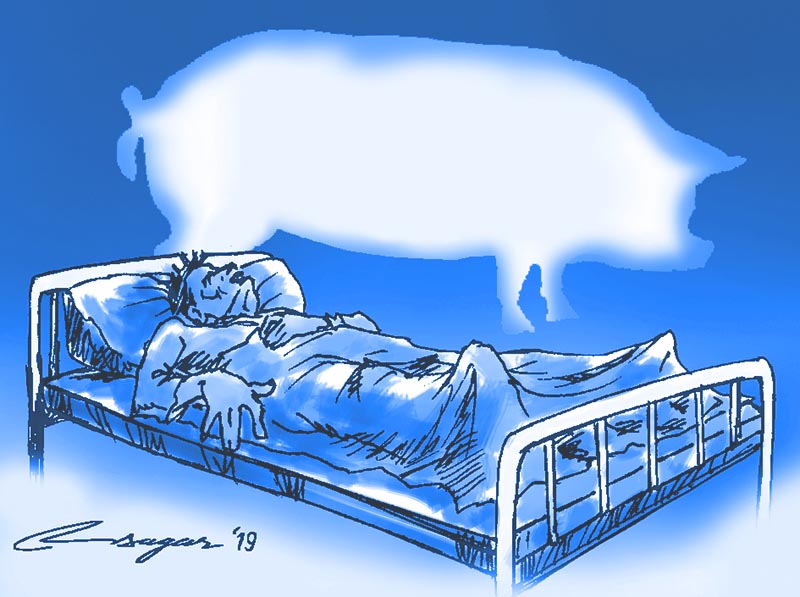Swine flu threat: New challenges ahead
Air pollution has now become a public health concern in Nepal, especially in Kathmandu. It can affect the respiratory system, and there is growing evidence of a link between air pollution and increased hospital admission in flu-related cases
A week ago, an adult patient was airlifted to India for further treatment after his medical conditions progressively deteriorated, despite undergoing intensive care in Kathmandu. He was being treated for pneumonia. According to family members, the patient was suffering from “influenza-like illness”, which means fever of more than 100 degrees F, cough and a sore throat without a known cause other than influenza. Similar symptoms were also seen among the patient’s family members, although their symptoms improved on their own. In India, the airlifted patient was diagnosed with influenza A (H1N1) pdm09, generally known as “swine flu” among the public. Similarly, nearly half a dozen swine flu cases are being treated in the ICUs in different hospitals of Kathmandu. It shows that swine flu is making a comeback in Nepal this winter.
Recently, a young doctor visited our hospital with laboratory-confirmed H1N1 pdm09 subtype of influenza A virus. In such cases, not only the general public but also healthcare providers show anxiety and feel unsafe.
A couple of years ago, the flu virus had caused widespread panic among the doctors in a medical campus in Kathmandu that ultimately resulted in flu mass vaccination.
A similar incident had happened in one of the medical colleges in India some years ago, too. It shows that frontline healthcare providers are not safe and can easily get infected while treating their patients. It is well known and documented that the best way to protect oneself from the flu virus and to prevent its spread is to get vaccinated annually. It is, however, essential to know or understand which subtype (or strain) of the influenza virus is circulating in the country. On the basis of that information, vaccines can be recommended. Since the introduction of the H1N1 pdm09 in 2009, a strain known as California has been found circulating in Nepal. However, recently the WHO has recommended switching from the California to the Michigan stain to be included in the vaccine composition for the sub-continent. In fact, the Michigan strain of H1N1 pdm09 was first discovered in 2017 and has since been circulating in India. Unfortunately, whether this strain has already arrived or any new strain is circulating in Nepal remains unknown. Thus, the effectiveness of the flu vaccine that is currently available in Nepal is still questionable. The government should identify the strain that is circulating disseminate information to the healthcare providers, so that they can recommend an effective vaccine to their patients.
Until now, hospitals in Nepal do not have separate ICU/ventilator rooms for patients with flu-related complications, meaning serious and unstable patients, other than flu-related cases, are also being treated together in the same ICU/ventilator rooms. Such a condition can create an opportunity to spread the virus to or among the serious patients. To prevent the hospital-acquired influenza virus, hospitals must have their own separate ICU/ventilator or isolation rooms, especially designed to manage airborne transmissible infectious diseases. Sukraraj Tropical and Infectious Disease Hospital (STIDH) has such a facility, however, it has not yet set up a state-of-the-art isolation or ICU/ventilator room for highly pathogenic air-borne infectious diseases. Influenza virus is known to be more pathogenic, particularly among people older than 65 years, people with chronic diseases, pregnant women and infants under the age of six months. Young adults are physically more active and outgoing, and, therefore, they can carry the virus home and pass it on to their family members. In my experience, old people are being admitted or rushed to the emergency rooms in greater numbers during the flu seasons owing to its complications. This has happened because they are late to inform their family members about their conditions due to lack of knowledge about the early symptoms and the consequences. To reduce the
flu- related mortality rate, policymakers and doctors should not take flu patients lightly during the flu season, especially if they are over 65 years because they rapidly develop viral pneumonia.
Air pollution has now become a public health concern in Nepal, especially in rapidly urbanising cities like Kathmandu. Air pollution can affect the respiratory system, and there is growing evidence of a relationship between air pollution and increased hospital admission in flu-related cases. At present, there is no adequate evidence of impact of air pollution on influenza viruses. Therefore, the policy makers should conduct environmental research to understand the association amongst air pollution,
flu virus and human health in Nepal.
Swine flu virus was first reported in Nepal in May 2009. Since then, Nepal has been experiencing swine flu every season annually. However, new challenges, such as flu panic among healthcare providers, unavailability of separate ICUs/ventilator rooms to treat flu-related complications, inadequate knowledge about early flu symptoms and its possible consequences among vulnerable older age groups, unknown circulation of flu strains, and the impact of air pollution on flu viruses are emerging and need to be addressed.
Dr Pun is Chief, Clinical Research Unit,Sukraraj Tropical & Infectious Disease Hospital






